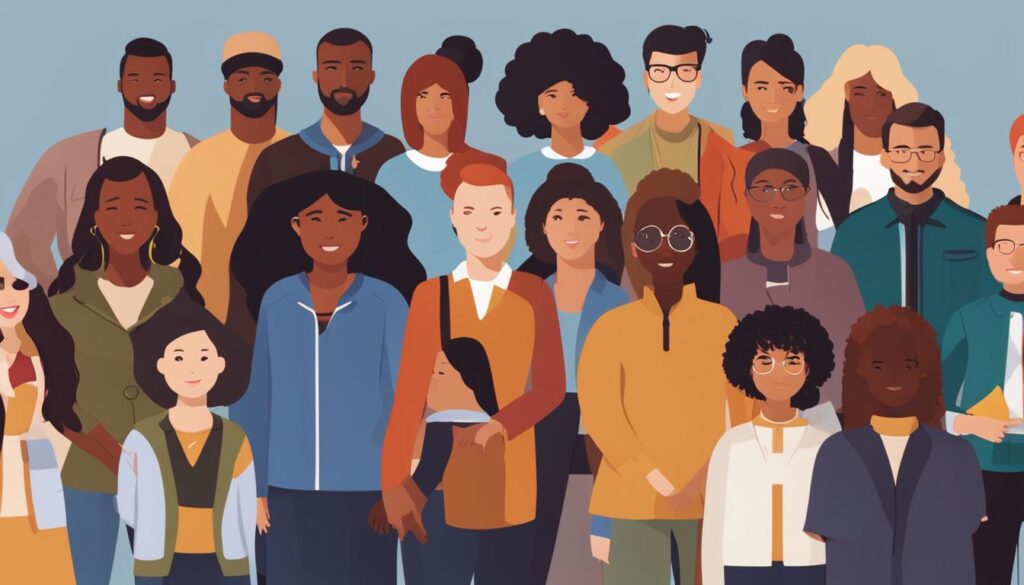Hello, and welcome to this article where we will explore the concept of diversity and inclusion and ask ourselves whether they are more than just buzzwords. We live in a world where these terms are often thrown around, but do we truly understand the importance of diversity and inclusion in our society?

At their core, diversity and inclusion represent the recognition and acceptance of differences among individuals. It’s about creating a society where everyone feels valued, respected, and included, regardless of their background, race, ethnicity, gender, sexual orientation, or any other factor that makes them unique.
While some may see diversity and inclusion as nothing more than trendy catchphrases, the truth is that these values are crucial in creating a fair and equitable society. Diversity and inclusion should be more than just words; they should be integral parts of our actions and beliefs.
Key Takeaways
- Diversity and inclusion are more than just buzzwords.
- They represent the acceptance and celebration of differences among individuals.
- Creating a fair and equitable society requires embracing diversity and inclusion.
Understanding the Impact of Diversity and Inclusion
As an advocate for diversity and inclusion, I am well aware of the benefits that embracing these values can bring to our lives and workplaces. Not only does it promote a more tolerant and accepting society, but it also drives innovation and creativity, leading to a more prosperous and successful business environment.
Benefits of Diversity and Inclusion
Studies have shown that diverse teams are more productive and efficient, leading to better decision-making and problem-solving. By creating a workplace that welcomes people of different backgrounds, skills, and perspectives, organizations can foster a culture of collaboration, creativity, and innovation. This, in turn, can lead to increased profits and success, as diverse teams have been shown to outperform homogeneous teams in various industries.
Creating Inclusive Workplaces
Creating an inclusive workplace goes beyond hiring a diverse workforce. It involves promoting an environment where everyone feels valued, respected, and heard. This can be achieved through various strategies such as providing opportunities for employee feedback, ensuring equal access to resources and opportunities, and celebrating diversity and cultural differences. Organizations can also implement diversity and inclusion training programs to educate employees on the importance of these values and how to foster an inclusive workplace culture.
Diversity and Inclusion Strategies
Organizations can adopt various diversity and inclusion strategies to promote a more inclusive culture. Some of these strategies include implementing flexible work policies to accommodate diverse needs, ensuring equal pay and promotion opportunities, and engaging in community outreach programs to connect with a diverse range of people. By embracing diversity and inclusion, organizations can not only attract top talent but also improve employee retention rates and overall job satisfaction.
In conclusion, embracing diversity and inclusion can have a significant impact on our workplaces and society as a whole. By promoting a culture of acceptance, respect, and inclusivity, we can create a better world for everyone.
The Role of Diversity and Inclusion in the Workplace
As I mentioned in the previous section, diversity and inclusion are essential values that should be embraced by everyone – from individuals to organizations. In this section, I want to emphasize the importance of these values in the workplace and highlight the initiatives that organizations can take to foster a more inclusive culture.
Having a diverse team in the workplace has numerous benefits. For example, it can improve creativity, boost innovation, and increase problem-solving capabilities. Additionally, having a diverse workforce can be advantageous in appealing to a wider customer base and developing better marketing strategies.
However, it’s not enough to just have a diverse team – it’s essential to create an inclusive workplace culture. Inclusive workplaces are those where all individuals feel valued, respected, and supported, regardless of their differences. This means not only promoting diversity but also actively working to reduce biases and discrimination in the workplace.
Diversity and inclusion initiatives
So, what can organizations do to create a more inclusive environment? There are several diversity and inclusion initiatives that companies can implement:
| Initiative | Description |
|---|---|
| Diversity and Inclusion Training | Providing employees with training on diversity and inclusion can help them understand the importance of these values and how they can promote them in their work. |
| Diversity Recruiting | Actively recruiting individuals from diverse backgrounds can help increase diversity in the workplace. |
| Inclusive Policies and Practices | Having policies and practices that promote inclusivity, such as flexible work arrangements and diverse task forces, can help create a more welcoming environment for everyone. |
| Employee Resource Groups | Employee resource groups (ERGs) provide a platform for employees to connect with others who share similar backgrounds and experiences, helping to foster a sense of belonging and community. |
These are just a few examples of the many initiatives that organizations can take to promote diversity and inclusion in the workplace. Implementing these initiatives can not only benefit individual employees but also lead to improved overall performance for the organization.

But it’s not always easy to implement these initiatives and create an inclusive workplace culture. There may be challenges along the way, such as resistance to change or unconscious biases. However, by acknowledging and addressing these challenges, organizations can work towards creating a more diverse and inclusive environment.
Overall, embracing diversity and inclusion in the workplace is not only the right thing to do but also makes good business sense. By creating a more welcoming and supportive environment for all employees, organizations can foster a culture of innovation, creativity, and success.
The Power of Diversity and Inclusion Programs
As I discussed in the previous section, diversity and inclusion can have a significant impact on the workplace and beyond. To fully embrace these values, organizations can implement diversity and inclusion programs that help drive positive change.
Implementing diversity and inclusion programs can bring a host of benefits to organizations, including:
- Increased employee satisfaction and engagement
- Enhanced innovation and creativity
- Improved decision-making and problem-solving abilities
- Expanded customer base and improved customer relations
To reap these benefits, organizations can implement a variety of diversity and inclusion programs, including:
- Diversity recruiting initiatives: These initiatives can help organizations build a more diverse workforce by targeting underrepresented groups in job postings and outreach efforts.
- Diversity training: Providing employees with diversity and inclusion training can help create a more inclusive workplace culture and promote awareness and sensitivity to different backgrounds and perspectives.
- Mentorship and sponsorship programs: These programs can help develop and retain underrepresented talent within an organization and provide mentorship and guidance for career growth.
- Employee resource groups: These groups can provide a sense of community and support for underrepresented employees and help promote diversity and inclusion within the organization.
It’s important to note that implementing diversity and inclusion programs is just the beginning. These programs must be continuously evaluated and improved to ensure they are effective and impactful. Additionally, these programs should be a part of a larger, comprehensive strategy for creating an inclusive workplace that values diversity and promotes equity.

Overcoming Challenges in Diversity and Inclusion
As much as diversity and inclusion are crucial values to embrace, there are various challenges that organizations may face when trying to implement them. One of these obstacles is the lack of awareness and understanding of the importance of diversity and inclusion. Some people may view these concepts as mere buzzwords or feel that they do not apply to their specific situation. However, it is essential to highlight their value and their crucial role in shaping a better future for all.
Another challenge organizations may face is resistance to change. Some individuals may feel uncomfortable with the idea of change and may push back against diversity and inclusion initiatives. It is essential to approach this resistance with empathy and understanding, and emphasize that diversity and inclusion are not about taking away opportunities from certain groups but rather creating equal opportunities for all.
Inadequate resources or budget can also present a challenge when trying to implement diversity and inclusion programs. Without adequate resources, it may be challenging to provide the necessary training and education to employees. However, there are various affordable and accessible resources available, such as free online training programs and webinars, that can provide a starting point for organizations looking to implement diversity and inclusion initiatives.
Overcoming the Challenges: Strategies for Success
Overcoming these challenges may seem daunting, but there are various strategies that organizations can employ to ensure success in their diversity and inclusion efforts. The first step is to educate and raise awareness about the importance of these values. Providing employees with the necessary information and highlighting success stories can help to create a positive and inclusive environment.
Another strategy for success is to involve employees in the process. When individuals feel like they have a stake in the success of diversity and inclusion initiatives, they are more likely to support and embrace them. Providing opportunities for feedback and input can help to create a sense of ownership and investment in the organization’s diversity and inclusion efforts.
Organizations can also address resistance to change by providing clear and concise communication about the benefits of diversity and inclusion, emphasizing that it is not about taking anything away from anyone. Rather, it is about creating equal opportunities for all individuals to succeed.
Conclusion
In conclusion, throughout this article, we have explored the concept of diversity and inclusion and its importance in our society. It is clear that these values are more than just buzzwords; they are values that should be embraced by all individuals and organizations.
The benefits of diversity and inclusion cannot be overstated. Inclusive workplaces that value diversity have been shown to be more innovative and productive. It is therefore imperative that we strive to create more diverse and inclusive work environments.
Although there may be challenges in promoting diversity and inclusion, we must remain committed to this goal. It is only through continuous efforts that we can create a world that values and celebrates the differences that make us unique.
Ultimately, the importance of diversity and inclusion cannot be ignored. By embracing these values, we can create a better world for ourselves and future generations. Let us continue to work towards a more inclusive and diverse society.
The Importance of Diversity and Inclusion
Diversity and inclusion are essential values that promote equality and create a more vibrant and dynamic world. These values must be embraced by all individuals and organizations to promote innovation, productivity, and ultimately, a better world.
FAQ
What is diversity and inclusion?
Diversity and inclusion refer to the practice of creating an environment that values and embraces individuals from diverse backgrounds, including differences in race, gender, ethnicity, sexual orientation, age, and more. It goes beyond mere representation and aims to ensure that everyone feels included and valued.
Why are diversity and inclusion important?
Diversity and inclusion are important because they foster innovation, creativity, and better decision-making. By embracing diverse perspectives and experiences, organizations can benefit from a wider range of ideas and solutions. Additionally, creating inclusive environments promotes equality and social justice, leading to a more harmonious society.
How can diversity and inclusion be promoted in the workplace?
There are several strategies organizations can employ to promote diversity and inclusion in the workplace. This includes implementing inclusive hiring practices, offering diversity training programs, creating employee resource groups, and fostering a culture of respect and belonging. It is crucial for organizations to prioritize diversity and inclusion and take active steps towards creating a more inclusive work environment.
What are the benefits of diversity and inclusion programs?
Diversity and inclusion programs can bring numerous benefits to both organizations and individuals. They can enhance employee engagement, improve productivity, and attract top talent. Additionally, fostering a diverse and inclusive workplace culture can lead to higher employee satisfaction, decreased turnover rates, and better overall organizational performance.
What are some challenges in implementing diversity and inclusion initiatives?
Implementing diversity and inclusion initiatives can come with certain challenges. Some potential obstacles include resistance to change, unconscious biases, lack of awareness and understanding, and difficulty in measuring the impact of these initiatives. However, by addressing these challenges head-on and fostering a culture of inclusivity, organizations can overcome these barriers and create meaningful change.

